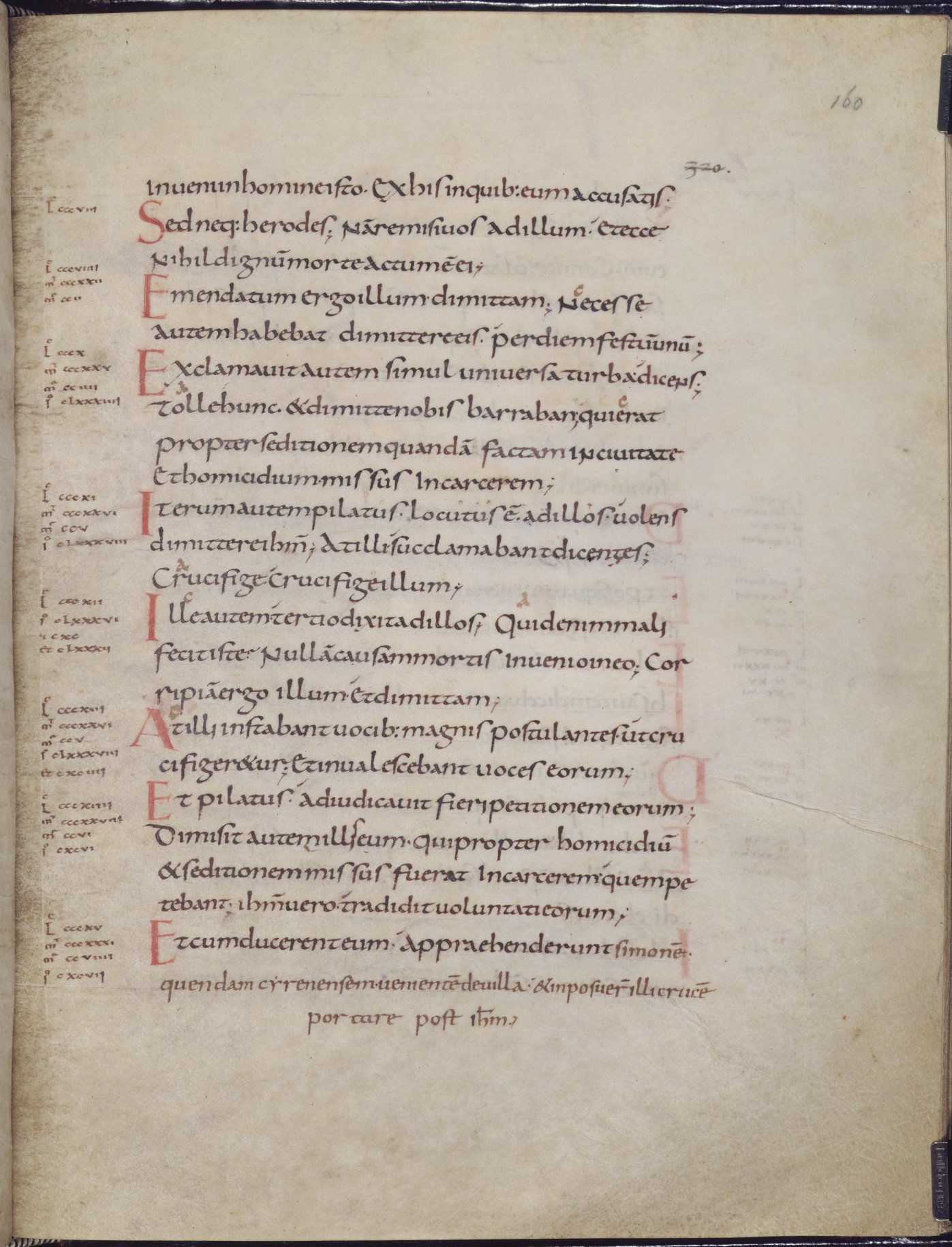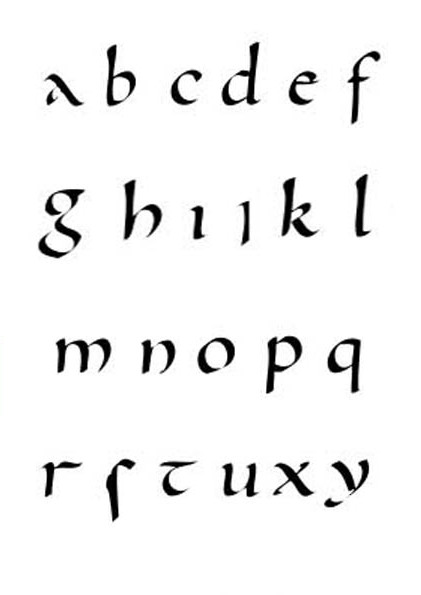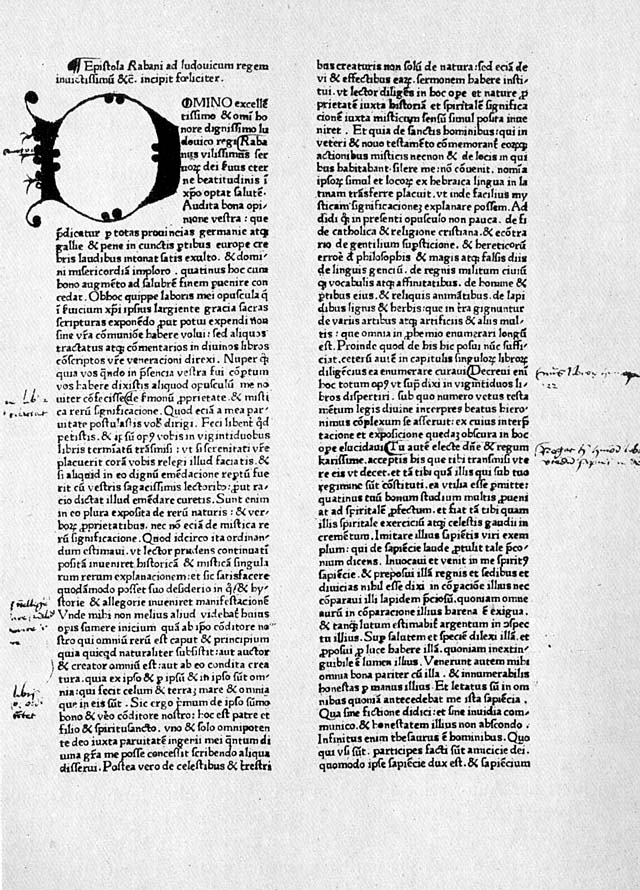|
Alcuin
Alcuin of York (; la, Flaccus Albinus Alcuinus; 735 – 19 May 804) – also called Ealhwine, Alhwin, or Alchoin – was a scholar, clergyman, poet, and teacher from York, Northumbria. He was born around 735 and became the student of Archbishop Ecgbert at York. At the invitation of Charlemagne, he became a leading scholar and teacher at the Carolingian court, where he remained a figure in the 780s and 790s. Before that, he was also a court chancellor in Aachen. "The most learned man anywhere to be found", according to Einhard's ''Life of Charlemagne'' (–833), he is considered among the most important intellectual architects of the Carolingian Renaissance. Among his pupils were many of the dominant intellectuals of the Carolingian era. During this period, he perfected Carolingian minuscule, an easily read manuscript hand using a mixture of upper- and lower-case letters. Latin paleography in the eighth century leaves little room for a single origin of the script, ... [...More Info...] [...Related Items...] OR: [Wikipedia] [Google] [Baidu] |
Propositiones Ad Acuendos Juvenes
The medieval Latin manuscript ''Propositiones ad Acuendos Juvenes'' ( en, Problems to Sharpen the Young) is one of the earliest known collections of recreational mathematics problems. David Darling, ''The Internet Encyclopedia of Science''. Accessed on line February 7, 2008. The oldest known copy of the manuscript dates from the late 9th century. The text is attributed to (died 804.) Some editions of the text contain 53 problems, others 56. It has been translated into English by John Hadley, with annotations by John Hadley and . [...More Info...] [...Related Items...] OR: [Wikipedia] [Google] [Baidu] |
Charlemagne
Charlemagne ( , ) or Charles the Great ( la, Carolus Magnus; german: Karl der Große; 2 April 747 – 28 January 814), a member of the Carolingian dynasty, was King of the Franks from 768, King of the Lombards from 774, and the first Emperor of the Romans from 800. Charlemagne succeeded in uniting the majority of western and central Europe and was the first recognized emperor to rule from western Europe after the fall of the Western Roman Empire around three centuries earlier. The expanded Frankish state that Charlemagne founded was the Carolingian Empire. He was canonized by Antipope Paschal III—an act later treated as invalid—and he is now regarded by some as beatified (which is a step on the path to sainthood) in the Catholic Church. Charlemagne was the eldest son of Pepin the Short and Bertrada of Laon. He was born before their canonical marriage. He became king of the Franks in 768 following his father's death, and was initially co-ruler with his brot ... [...More Info...] [...Related Items...] OR: [Wikipedia] [Google] [Baidu] |
Carolingian Renaissance
The Carolingian Renaissance was the first of three medieval renaissances, a period of cultural activity in the Carolingian Empire. It occurred from the late 8th century to the 9th century, taking inspiration from the Christian Roman Empire of the fourth century. During this period, there was an increase of literature, writing, visual arts, architecture, music, jurisprudence, liturgical reforms, and scriptural studies. The movement occurred mostly during the reigns of Carolingian rulers Charlemagne and Louis the Pious. It was supported by the scholars of the Carolingian court, notably Alcuin of York. Charlemagne's ''Admonitio generalis'' (789) and '' Epistola de litteris colendis'' served as manifestos. The effects of this cultural revival were mostly limited to a small group of court '' literati''. According to John Contreni, "it had a spectacular effect on education and culture in Francia, a debatable effect on artistic endeavors, and an unmeasurable effect on what mattere ... [...More Info...] [...Related Items...] OR: [Wikipedia] [Google] [Baidu] |
Willibrord
Willibrord (; 658 – 7 November AD 739) was an Anglo-Saxon missionary and saint, known as the "Apostle to the Frisians" in the modern Netherlands. He became the first bishop of Utrecht and died at Echternach, Luxembourg. Early life His father, named Wilgils or Hilgis, was styled by Alcuin as a Saxon of Northumbria. Newly converted to Christianity, Wilgils entrusted his son as an oblate to the Abbey of Ripon, and withdrew from the world, constructing a small oratory, near the mouth of the Humber, dedicated to Saint Andrew. The king and nobles of the district endowed him with estates until he was at last able to build a church, over which Alcuin afterwards ruled. Willibrord grew up under the influence of Wilfrid, Bishop of York. Later he joined the Benedictines. He spent the years between the ages of 20 and 32 in the Abbey of Rath Melsigi, in County Carlow, Ireland, which was a centre of European learning in the 7th century. Frisia During this time he studied under Ecgb ... [...More Info...] [...Related Items...] OR: [Wikipedia] [Google] [Baidu] |
Northumbria
la, Regnum Northanhymbrorum , conventional_long_name = Kingdom of Northumbria , common_name = Northumbria , status = State , status_text = Unified Anglian kingdom (before 876)North: Anglian kingdom (after 876)South: Danish kingdom (876–914)South: Norwegian kingdom (after 914) , life_span = 654–954 , flag_type = Oswald's Stripes, the provincial flag of Northumbria and red was previously purple , image_coat = , image_map = Map_of_the_Kingdom_of_Northumbria_around_700_AD.svg , image_map_size = 250 , image_map_caption = Northumbria around 700 AD , image_map2 = , image_map2_size = , image_map2_caption = , government_type = Monarchy , year_start = 653 , year_end = 954 , event_end = South is annexed by Kingdom of England , event1 = South is annexed by the Danelaw , date_even ... [...More Info...] [...Related Items...] OR: [Wikipedia] [Google] [Baidu] |
Quaestiones In Genesim
''Quaestiones in Genesim'' is a commentary on the biblical Book of Genesis by the Anglo-Saxon scholar Alcuin, addressed to his protege Sigewulf, comprising 281 questions and corresponding answers about Genesis. It has been dated by Michael Fox to around 796. Surviving in at least 52 manuscripts, the text seems to have been among the most popular biblical commentaries of the early Middle Ages, and was cited by Claudius of Turin, Hrabanus Maurus, Angelomus of Luxeuil, Haimo of Auxerre, and Remigius of Auxerre. Around two centuries after its original composition, it was translated into Old English Old English (, ), or Anglo-Saxon, is the earliest recorded form of the English language, spoken in England and southern and eastern Scotland in the early Middle Ages. It was brought to Great Britain by Anglo-Saxon settlers in the mid-5th c ... by Ælfric of Eynsham as ''Interrogationes Sigewulfi''.Alfred Tessmann, ''Ælfrics ae Bearbeitung der Interrogationes Sigewulfi Presbyteri ... [...More Info...] [...Related Items...] OR: [Wikipedia] [Google] [Baidu] |
Carolingian Minuscule
Carolingian minuscule or Caroline minuscule is a script which developed as a calligraphic standard in the medieval European period so that the Latin alphabet of Jerome's Vulgate Bible could be easily recognized by the literate class from one region to another. It is thought to have originated before AD 778 at the scriptorium of the Benedictine monks of Corbie Abbey, about north of Paris, and then developed by Alcuin of York for wide use in the Carolingian Renaissance. Alcuin himself still wrote in a script which was a precursor the Carolingian minuscule, which slowly developed over three centuries. He was most likely responsible for copying and preserving the manuscripts and upkeep of the script. It was used in the Holy Roman Empire between approximately 800 and 1200. Codices, pagan and Christian texts, and educational material were written in Carolingian minuscule. After blackletter developed out of it, the Carolingian minuscule became obsolete, until the 14th century Italian ... [...More Info...] [...Related Items...] OR: [Wikipedia] [Google] [Baidu] |
York
York is a cathedral city with Roman origins, sited at the confluence of the rivers Ouse and Foss in North Yorkshire, England. It is the historic county town of Yorkshire. The city has many historic buildings and other structures, such as a minster, castle, and city walls. It is the largest settlement and the administrative centre of the wider City of York district. The city was founded under the name of Eboracum in 71 AD. It then became the capital of the Roman province of Britannia Inferior, and later of the kingdoms of Deira, Northumbria, and Scandinavian York. In the Middle Ages, it became the northern England ecclesiastical province's centre, and grew as a wool-trading centre. In the 19th century, it became a major railway network hub and confectionery manufacturing centre. During the Second World War, part of the Baedeker Blitz bombed the city; it was less affected by the war than other northern cities, with several historic buildings being gutted and restore ... [...More Info...] [...Related Items...] OR: [Wikipedia] [Google] [Baidu] |
Rabanus Maurus
Rabanus Maurus Magnentius ( 780 – 4 February 856), also known as Hrabanus or Rhabanus, was a Frankish Benedictine monk, theologian, poet, encyclopedist and military writer who became archbishop of Mainz in East Francia. He was the author of the encyclopaedia ''De rerum naturis'' (''"On the Natures of Things"''). He also wrote treatises on education and grammar and commentaries on the Bible. He was one of the most prominent teachers and writers of the Carolingian age, and was called "Praeceptor Germaniae", or "the teacher of Germany". In the most recent edition of the Roman Martyrology ('' Martyrologium Romanum'', 2004, pp. 133), his feast is given as 4 February and he is qualified as a Saint ('sanctus'). Life Rabanus was born of noble parents in Mainz. The date of his birth remains uncertain, but in 801 he was ordained a deacon at Benedictine Abbey of Fulda in Hesse, where he had been sent to school and had become a monk. At the insistence of Ratgar, his abbot, he went t ... [...More Info...] [...Related Items...] OR: [Wikipedia] [Google] [Baidu] |
Beornrad (archbishop Of Sens)
Beornrad (also spelled Beornred; died 797) was Archbishop of Sens from 785/6 until his death. He was Alcuin's cousin and was also related to Willibrord by blood. Beornrad had moved from Northumbria to the European mainland at an unknown date, and was appointed as the third abbot of Echternach in 775, succeeding Albert to the post. According to a letter-poem written by Alcuin, Beornrad had become part of the court of Charlemagne by the 770s. Though Beornrad was later appointed Archbishop of Sens, he retained the abbacy of Echternach until his death. He was succeeded in his bishopric by Ragembert and in his abbacy by Ado. Beornrad was buried in the Abbey of Saint-Pierre-le-Vif The Abbey of Saint-Pierre-le-Vif (french: Abbaye de Saint-Pierre-le-Vif) was a Rule of St Benedict, Benedictine monastery just outside the walls of Sens, France, in the Archdiocese of Sens. History The first abbot of Saint-Pierre-le-Vif, Saint ... in Sens. References Sources * * * {{DEFAULTSORT:Be ... [...More Info...] [...Related Items...] OR: [Wikipedia] [Google] [Baidu] |
Ecgbert Of York
Ecgbert (died 19 November 766) was an 8th-century cleric who established the archdiocese of York in 735. In 737, Ecgbert's brother became king of Northumbria and the two siblings worked together on ecclesiastical issues. Ecgbert was a correspondent of Bede and Boniface and the author of a legal code for his clergy. Other works have been ascribed to him, although the attribution is doubted by modern scholars. Early life and career Ecgbert was the son of Eata, who was descended from the founder of the kingdom of Bernicia. His brother Eadberht was king of Northumbria from 737 to 758. Ecgbert went to Rome with another brother, and was ordained deacon while still there.Mayr-Harting "Ecgberht" ''Oxford Dictionary of National Biography'' Ecgbert has been claimed to have been a student of Bede, who much later visited with Ecgbert in 733 at York,Blair ''World of Bede'' p. 305 but this statement may simply mean that Ecgbert was a student of Bede's writings, and not that he was formally ta ... [...More Info...] [...Related Items...] OR: [Wikipedia] [Google] [Baidu] |
Tours
Tours ( , ) is one of the largest cities in the region of Centre-Val de Loire, France. It is the prefecture of the department of Indre-et-Loire. The commune of Tours had 136,463 inhabitants as of 2018 while the population of the whole metropolitan area was 516,973. Tours sits on the lower reaches of the Loire, between Orléans and the Atlantic coast. Formerly named Caesarodunum by its founder, Roman Emperor Augustus, it possesses one of the largest amphitheaters of the Roman Empire, the Tours Amphitheatre. Known for the Battle of Tours in 732 AD, it is a National Sanctuary with connections to the Merovingians and the Carolingians, with the Capetians making the kingdom's currency the Livre tournois. Saint Martin, Gregory of Tours and Alcuin were all from Tours. Tours was once part of Touraine, a former province of France. Tours was the first city of the silk industry. It was wanted by Louis XI, royal capital under the Valois Kings with its Loire castles and city ... [...More Info...] [...Related Items...] OR: [Wikipedia] [Google] [Baidu] |






